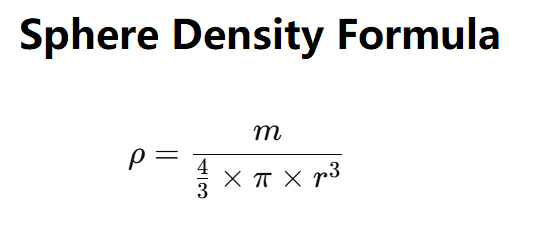 Home
Home
 Back
Back

Sphere density is the mass per unit volume of a spherical object, typically measured in kg/m³. For a sphere, the density can be calculated from its mass and volume, where the volume is determined by the sphere’s radius using the formula \( V = \frac{4}{3} \pi r^3 \). The density is then \(\rho = \frac{m}{V}\). This calculator computes both the radius (if volume is provided) and the density based on the mass and volume of the sphere.
For example, a sphere with a mass of 25 kg and a volume of 5 m³ has a density of 5 kg/m³, and its radius can be derived from the volume.
Density Calculation: The density is calculated using the formula:
\(\rho = \frac{m}{V}\)
Radius Calculation: The radius is calculated using the sphere volume formula:
\(V = \frac{4}{3} \pi r^3\)
Rearrange for radius: \(r = \left(\frac{3V}{4\pi}\right)^{1/3}\)
Where:
Example Calculation: Let’s calculate based on the image example with a mass of 25 kg and a volume of 5 m³:
Use the form above to input your mass and volume values with the desired units, and the calculator will compute the radius and density.
The SI unit for density is kilogram per cubic meter (kg/m³). Other convenient units include:
Imperial units for density include:
The calculator displays density in multiple units for convenience.
Density varies depending on the material of the sphere. Some standard densities at room temperature (20 °C) include:
Use this calculator to compare the density of your sphere against these standards.
The radius of a sphere is the distance from the center to any point on its surface. For a sphere, the volume is related to the radius by \( V = \frac{4}{3} \pi r^3 \), allowing the radius to be calculated if the volume is known.
How do you calculate the radius of a sphere from volume?
To calculate the radius:
What is the density of a sphere with mass 25 kg and volume 5 m³?
The density is \(\rho = \frac{25}{5} = 5 \, \text{kg/m³}\), and the radius is approximately 1.0608 m, as shown in the image.